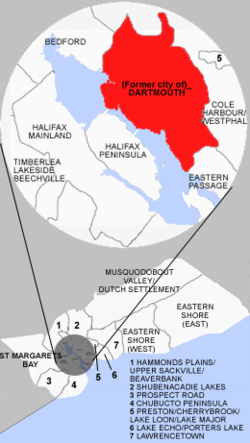Albro Lake, Nova Scotia
| Albro Lake, Nova Scotia | |
|---|---|
| Neighbourhood | |
 Shown with a RED dot, the location of the neighbourhood of Albro Lake within the community of Dartmouth, HRM, Nova Scotia | |
| Coordinates: 44°41′02″N 63°34′52″W / 44.68389°N 63.58111°WCoordinates: 44°41′02″N 63°34′52″W / 44.68389°N 63.58111°W | |
| Country |
|
| Province |
|
| Municipality | Halifax Regional Municipality |
| Community | Dartmouth |
| Community council | Harbour East - Marine Drive Community Council |
| District | 6 - Harbourview - Burnside - Dartmouth East |
| Elevation | 60 m (200 ft) |
| Time zone | AST (UTC-4) |
| • Summer (DST) | ADT (UTC-3) |
| Postal code | B3A |
| Area code(s) | 902 |
|
Part of a series about Places in Nova Scotia | |
Albro Lake is a neighbourhood in the north end of the community of Dartmouth in Nova Scotia's Halifax Regional Municipality.
Albro Lake takes its name from the shallow freshwater lake of the same name. The lake was named after Samuel Albro, who first settled in the area in the 1740s with a group of other residents from Portsmouth, Rhode Island. The neighbourhood includes the Highfield Park and Crystal Heights; both being developments in the Albro Lake neighbourhood which were named by their developers. A newer development Lancaster Ridge is built on the former Department of National Defence housing lands. The streets are named for aircraft used by the Royal Canadian Air Force.[1]
Albro Lake is bounded by Primrose Street to the west, Woodland Avenue to the east, Highway 111 to the north, and Trunk 7 to the south.
The neighbourhood developed during the post-war years and until 1968 hosted the Royal Canadian Navy's Naval Radio Station Albro Lake (land which was subsequently developed into Highfield Park).
The housing in the neighbourhood is a mixture, ranging from high-density low-rental apartment buildings in Highfield Park built during the 1970s and 1980s, to small single-family houses, duplexes, townhouses and small apartment buildings. The socio-economic indicators for the neighbourhood show that it comprises mostly low-to-middle income households.
Neighbourhood amenities
Parks
- Albro Lake Park
- Golden Acres Park
Natural areas
- Albro Lake
- Little Albro Lake
- Martin Lake
Sports facilities
- Grey Arena
Schools
- John MacNeil Elementary School
- John Martin Junior High
- Harbour View Elementary School
Community facilities
Memorials
- Halifax Explosion memorial
- Located at the intersection of Albro Lake Road and Pinecrest Drive, this memorial is dedicated to the victims of the Halifax Explosion. Part of a large-calibre surface defense gun from the French ship Mont Blanc landed adjacent to the memorial site, 1.5 kilometres from the explosion centre.
- Jason MacCullough Memorial Park
- Memorial park dedicated to the victim of an unsolved murder in the neighborhood.